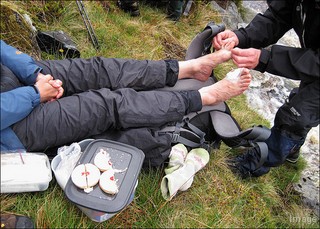Bunion Treatment Options Guide
Many who unfortunately experience the pain of bunions seek bunion treatment without surgery for swelling and inflammation often associated with this condition.
Bunions are characterized as the inflammation of the bone and tissue around the joint at the tip of the base of the large toe, also known as the metatarsophalangeal joint.
Bunions cause huge bumps to occur on the joint of the large toe. These bumps force the large toe to become displaced and turn inward toward the second toe, which causes surrounding tissues to become inflamed.
When seeking bunions treatment options, there are two main methods: non surgical and surgical available at the current time.
Both provide relief of swelling, inflammation, and pain brought on by bunions; this brief article aims to discuss both in greater detail.
Non Surgical Bunion Correction – The Facts
Often, non surgical treatments are pursued to reduce pressure on the large toe and alleviate pain. Wearing roomy shoes is a popular method of providing bunion relief.
Typically, shoes with low or flat heels, with proper arch supports are best; it is important to avoid shoes that are tight, narrow, or have high-heels, seeing as they can easily stimulate bunion foot pain and swelling.
Pads are also a popular bunion home treatment.
These bunion pads are recommended because they easily remove pressure from the large toe and redistribute weight when walking, which takes pressure off of the large toe. A qualified health professional can often assist in finding the best pads for your foot condition.
Moleskin and felt patches are bunions treatment options often recommended. The use of these patches stops the bunion from coming in contact with shoes, which can be very comforting, especially when walking or running.
In addition to moleskin and felt patches, nonprescription medication is recommended as a popular non surgical treatment for bunions to reduce pain, swelling, and inflammation.
Common non-prescriptive medications include: acetaminophen and nonsteroidal anti-inflammatory drugs (NSAIDS), such as aspirin, and ibuprofen.
When taken as directed, these non-prescriptive medications easily reduce pain, swelling, and inflammation.
The use of ice is also a common foot bunion remedy. Cold compresses, applied for 10-to-20 minutes at at time greatly reduce inflammation brought on by bunions.
When applying cold compresses, it is also recommended elevating the feet above the head, which reduces excessive blood pooling in the feet.
Possibly the most effective non surgical bunion treatment at home methods are physical therapy, bunion splint, exercises and braces.
Each of these methods has been successfully proven to quickly relieve symptoms brought about by bunions, although temporarily.
While avoiding a long bunion surgery recovery time of many months is an incentive to pursue other forms of bunion relief, surgery is also recommended.
Examining Surgical Bunion Removal Options
Surgery is a common method of relieving sufferers from the symptoms of bunions, such as swelling, inflammation, and excruciating pain.
These methods should be considered in the case that nonsurgical methods, such as changing shoes, medication, and bunion pads, fail to relieve the pain and the ability to perform normal, daily activities are restricted.
Surgery is also recommended if the condition is severe; in this case immediate surgical hammertoe treatment should be considered. The purpose of surgery is to restore normal alignment to the joint within the large toe, and thereby relieve pain, swelling, and pain.
There are multiple types of surgeries; however, the best type of surgery depends on your present needs, and more importantly, the severity of your bunion(s).
The type of surgery selected also depends on the experience and familiarity of your surgeon with bunions. Search for a surgeon that offers multiple surgery types and performs them on a regular basis.
No two bunions are the same, and each surgery should be tailored to fit the need at hand.
Surgical treatment for bunions should be considered in the case that nonsurgical methods such as medications, pads, or cold compresses fail to work.
Regardless of the method of tailor’s bunion treatment chosen, surgical or nonsurgical, bunion relief can easily be achieved.


Leave a Reply